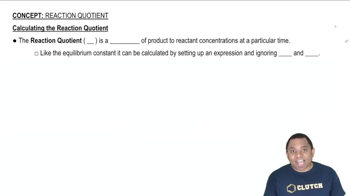Here are the essential concepts you must grasp in order to answer the question correctly.
Le Chatelier's Principle
Le Chatelier's Principle states that if a dynamic equilibrium is disturbed by changing the conditions, the position of equilibrium shifts to counteract the change. This principle helps predict how a system at equilibrium will respond to changes in concentration, pressure, or temperature, allowing us to determine the direction in which the reaction will shift.
Recommended video:
Equilibrium Constant (K)
The equilibrium constant (K) is a numerical value that expresses the ratio of the concentrations of products to reactants at equilibrium for a given reaction at a specific temperature. It provides insight into the extent of the reaction and helps in understanding how changes in concentration affect the position of equilibrium.
Recommended video:
Reaction Quotient (Q)
The reaction quotient (Q) is a measure of the relative concentrations of products and reactants at any point in a reaction, not just at equilibrium. By comparing Q to K, one can determine the direction in which the reaction will shift to reach equilibrium: if Q < K, the reaction shifts right (toward products), and if Q > K, it shifts left (toward reactants).
Recommended video:
 Verified step by step guidance
Verified step by step guidance


